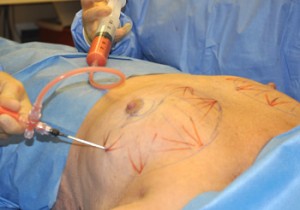Belly fat has been an historic scourge of the vast majority of the American population for a long time. Much of the popularity of liposuction can be traced to the desire to reduce unwanted belly fat. But to illustrate that even bad things have a silver lining, fat has been shown to be a dynamic reservoir of stem cells. Several studies have shown that abdominal fat has as much as 300x to 500x times more stem cells than bone marrow. And the lower abdomen appears to be even better than the upper abdomen with 3x to 5x as many of these precious cells.
Fat injections for either aesthetic or reconstructive purposes has caught on like wildfire in plastic surgery in just the past few years. Why such transplanted fat works more often than not is not exactly clear. It has been highly speculated that the stem cell component of the transplanted fat (stromal vascular fraction) is one of the reasons. While the scientific evidence to support that supposition has not yet been established, it is a fair assumption. Fat cells may be relatively hardy and some (or many) can survive the harshness of the harvest and transplantation process, but stem cells are probably even tougher.

Fat injections are starting to chip away at the traditional breast reconstruction options of implants and pedicled and free tissue transfers. Alone, fat and its stem cells are never going to completely replace mastectomy defects. (for lumpectomies it largely has) But fat injections are extremely helpful in improving the blood supply to damaged tissues, improving skin texture and adding a little volume under the mastectomy skin flaps. Fat injections are best thought of as a composite approach, improve the tissue bed initially with injection therapy and then add an implant for the final amount of volume needed as a last stage of the reconstruction.
For aesthetic augmentation, it is a slightly different story. Every women would like to have their breast augmentation done with their own fat and avoid an implanted medical device. But many women are not good candidates for fat injection breast augmentation because of the current size and shape of their breasts, their breast size goals or the amount of fat that they have to harvest. Current clinical work demonstrates that in the properly selected and motivated patient who only desires a small breast augmentation, good results can be achieved. But there remains unanswered questions which have to do with the accompanying stem cells that are transplanted. It is not known whether fat injections into the breast significantly interfere with breast cancer detection (mammograms and ultrasounds) due to fat necrosis and if they can increase the risk of breast cancer due to stem cell conversion.
Fat injections to the breast as as surgical technique is beyond being borne and is beginning to walk like a toddler. It still requires much study to make it work more consistently and patient selection remains critical. Along with that patient expectations must also be tempered as complications such as infection, cyst formation, irregularities and breast mound enlargement limitations can occur.
Dr. Barry Eppley
Indianapolis, Indiana


